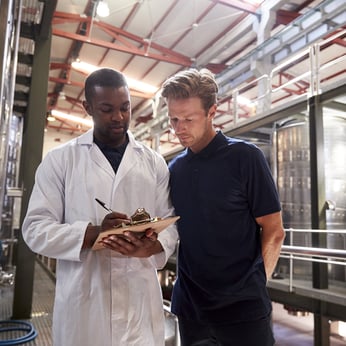Regulatory oversight is an essential part of every aspect of the food industry, and keeping up with regulatory changes is a must. Any facility is only as safe as the sum of its parts, so making sure everything and everyone is working in conjunction with set standards is vital.
Food auditors are tasked with looking at different aspects of operations to anticipate and mitigate food safety risks at every step. However, it’s worth noting that any audit is just a snapshot of the day it was conducted. Any defects outside the scope of the audit may not be uncovered. The solution to any potential audit gaps is certifying to one or more industry standards.
The Role of the Food Auditor and the Food Safety Audit Reports
The role of the food auditor—whether 1st, 2nd, or 3rd party—is to observe and evaluate the food safety process in a facility. Major violations identified during a third-party audit increase the chance of facility certifications being revoked, or not awarded at all. In the case of a supplier audit, poor results could mean a supplier might stop doing business with your organization which can put your business at risk for a shutdown. That being said, it's important to remember that no matter how it may seem, food safety auditors are not trying to "catch you" or purposefully shut down a facility for the fun of it. (We'll leave that to Hugo, the inspector from Bob's Burgers...) ASI's auditors for example are only there to help point you in the right direction as industry experts. 
No matter the type of audit, food auditors generally conduct inspections in five steps:
- Step 1 – Planning
- Step 2 – Execution
- Step 3 – Corrective and Preventative Action
- Step 4 – Verification
- Step 5 – Audit Evaluation
Food safety systems, quality assurance systems, grounds, building and equipment, and pest control are just the beginning of a comprehensive safety audit. Employee practices, receiving, storage and shipping, plant sanitation, and processing will also be under the food auditors’ microscope.
The results detailed by your food auditor will determine the schedule of your next facility safety inspection. Any major violations listed must be priority one for taking corrective and preventative action. Minor issues should be appropriately addressed and any corrective and preventative actions are to be recorded in detail for the food auditor. Additional opportunities and areas for improvement may also be detailed and should be addressed in order of importance to maintaining food safety in all operations.
What to Expect From a Food Safety Audit Report
Once you’ve had your first safety audit, and the food auditor has your initial Food Safety Audit Report in hand, what’s next? 
-
- Carefully review the audit summary and any notations listed in the initial portion of the Food Safety Audit Report.
- Corrective and Preventative Actions and recommended pathways to improvement will be described and assigned a complete by date in the final Audit Evaluation and scoring.
- Set a schedule to meet the completion dates noted by the food auditor, including the name of the person or team responsible for implementing and completing the recommended actions.
Preparation for Future Food Safety Audit Reports
Being audit-ready every day can mitigate problems for future audits. But in order to be effective, food safety requires constant vigilance and inspection readiness. The importance of following a well-documented and detailed food safety plan and/or HAACP plan for your plant cannot be understated. Regulatory inspectors will ask to review this plan as well as records that prove the food safety steps are being followed every day.
A designated onsite food auditor to oversee and coordinate safety efforts internally can help keep everything on track. The best way to achieve operating standards that are “Audit ready, every day” is to adhere to and certify your facility’s food safety standards to anticipate and prevent problems before they happen.
